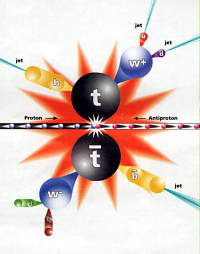Physicists at the Dzero operation fusion at Primilab measured the top quark mass with unprecedented precision.
Peter Rodgers, Physics Web

Physicists at the Dzero operation fusion at Primilab measured the top quark mass with unprecedented precision. The results have important implications for the search for the Higgs boson - the particle that is supposed to explain where the mass of particles comes from - and for the search for "new physics" beyond the standard model of elementary particles.
The top quark was discovered in the proton-antiproton accelerator at Paralab in 1995. It is the heaviest elementary particle discovered to date. The Dzero results are based on data taken before the accelerator was shut down in 1999 for upgrades. New data analyzes of the data from the first run give a new mean of the up quark mass. This mass stands at 178 gau plus or minus 4.3 gau. If you want to be precise, the mass is 178 geo divided by C squared, where C is the speed of light, but particle physicists tend to omit the C squared.
In the standard model the particle masses are created as a result of interaction with a field, called the Higgs field. According to the theory, it is possible to discover excited states of the Higgs field in the form of a particle, called the Higgs boson. The discovery of the Higgs - the only particle in the standard model, which has not yet been discovered experimentally - is considered one of the biggest challenges in particle physics. However, careful measurements of the up quark masses and the W+ and W- bosons, two of the particles that carry the electroweak force, allow physicists to determine upper and lower limits on the Higgs mass.
The new value of the up quark mass is about 5.3 GU higher than the previous value, which raises the estimates for the Higgs' mass from 96 GU to 117 GU. Furthermore, the upper limit on the Higgs mass rose from 219 Ga to 251 Ga. This is an extremely large mass, and may be too large for the current generation of particle accelerators, meaning that today's particle accelerators may not be able to detect the Higgs boson.
The discovery of the Higgs will allow particle physicists to search for physics beyond the standard model such as supersymmetry. Supersymmetric extensions to the Standard Model predict that all elementary particles, such as quarks, photons, and electrons, have supersymmetric counterparts.
"Not only has the Higgs mass estimate changed by about 25%, various restrictions on supersymmetric parameters are no longer valid thanks to the new information on the up quark mass," Greg Landsberg, a member of the Dzero team at Brown University, told Physics Web . According to Landsberg, using the new technique to analyze the results is equivalent to operating the accelerator for another three years. The CDF team, working on another detector in the accelerator, is now using the new technique, and is also applying it to the data from the second run of the upgraded accelerator.
Translation: Dikla Oren
The article on Physics Web
Physics expert
https://www.hayadan.org.il/BuildaGate4/general2/data_card.php?Cat=~~~870522691~~~95&SiteName=hayadan
